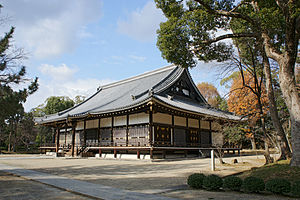- Ninna-ji
-
Ninna-ji 
Golden Hall (Main Hall) Information Denomination Shingon Buddhism Venerated Amida Buddha Founded 888 Founder(s) Emperor Uda Address 33 Ouchi Omuro
Ukyo-ku
KyotoCountry Japan Coordinates 35°01′50″N 135°42′50″E / 35.03056°N 135.71389°E Website http://www.ninnaji.or.jp Ninna-ji (仁和寺 Ninna-ji) is the head temple of the Omuro school of the Shingon Sect of Buddhism.[1] Located in western Kyoto, Japan, it was founded in AD 888 by the retired Emperor Uda. It is part of the "Historic Monuments of Ancient Kyoto", a UNESCO World Heritage Site.
Contents
History
Ninna-ji was founded in the early Heian period. In 886, Emperor Kōkō ordered the construction of the Nishiyama Goganji Temple to bless the nation and propagate Buddhist teachings, but he did not live to see its completion. Emperor Uda saw the construction to its completion in 888[2] and named it "Ninna" after the regnal year of the late Emperor Kōkō's reign. From 888 to 1869 it was traditional for reigning Emperors to send a son to the temple to take over as head priest when a vacancy arose.
After retiring from his throne, Emperor Uda became the first Monzeki, or aristocratic priest, of Ninna-ji. From then on until the end of the Edo period, the temple saw a succession of head priests of imperial lineage.
In 1467, the temple was destroyed by fire and fighting in the Ōnin War. It was rebuilt roughly 150 year later, thanks to the eldest son of Emperor Go-Yōzei, Kakushin Hosshinnō, who enlisted the help of Tokugawa Iemitsu, the third shogun of the Tokugawa shogunate. The resurrection coincided with the rebuilding of the Imperial Palace in Kyoto and thus received imperial funding.
The tradition of having aristocratic or persons of imperial lineage serve as chief of the temple ended with the 30th Monzeki, Junnin Hosshinnō in the late Edo period.
Most of the surviving buildings date from the 17th century, and include a five-story pagoda and an orchard of dwarf cherry trees. The temple itself features some beautifully painted screen walls, and a beautiful walled garden.
Buildings
- National Treasure of Japan
- Golden Hall
- Important Cultural Property of Japan
- Pagoda
- Kyozo
- Nio Gate
- Chumon
- Shoro
- Kannon-do
- Miei-do
- Chumon of Miei-do
- Kyusho-myojin
- Omotemon of Honbo
- Ryokaku-tei
- Hito-tei
- Other
- Chokushimon
- Shinden
- Reimeiden
- Kuro Shoin
- Shiro Shoin
See also
- List of Buddhist temples in Kyoto
- List of National Treasures of Japan (temples)
- List of National Treasures of Japan (ancient documents)
- List of National Treasures of Japan (paintings)
- List of National Treasures of Japan (sculptures)
- List of National Treasures of Japan (crafts-others)
- List of National Treasures of Japan (writings)
- For an explanation of terms concerning Japanese Buddhism, Japanese Buddhist art, and Japanese Buddhist temple architecture, see the Glossary of Japanese Buddhism.
External links
References
- ^ Ninna-ji Temple. Kyoto, Japan: Benrido Co., Ltd.. 2009. p. 1.
- ^ Ponsonby-Fane, Richard (1956). Kyoto: The Old Capital of Japan, 794-1869. University of Virginia: Ponsonby Memorial Society. p. 112. http://books.google.com/books?ei=8izETIfWEoa8cMrO3dcL&ct=result&id=kG1DAAAAYAAJ&dq=Kyoto%3A+The+Old+Capital+of+Japan&q=Ninna-ji+888#search_anchor. Retrieved 24 October, 2010.
Kyōto Daigo-ji · Ginkaku-ji1 · Kamigamo Shrine2 · Kinkaku-ji3 · Kiyomizu-dera · Koke-dera4 · Kōzan-ji · Nijō Castle · Ninna-ji · Nishi Honganji · Ryōan-ji · Shimogamo Shrine5 · Tenryū-ji · Tō-ji6
Uji Ōtsu 1 Jishō-ji 2 Kamowakeikazuchi Shrine 3 Rokuon-ji 4 Saihō-ji 5 Kamomioya Shrine 6 Kyōōgokoku-ji
Buddhist temples in Japan Japanese Buddhist architecture Architectonic elements Mon (gates) Buildings Chinjusha · chōzuya/temizuya · -dō · main hall (kon-dō, hon-dō, butsuden) · kuri · kyōzō or kyō-dō · shoinTō or Buttō (pagodas) Styles Others A-un · kenSchools and objects of worship Major schools Zen schools Nanto rokushū Objects of worship Amida Nyōrai · Benzaiten · Dainichi Nyorai · Jizō · Kannon · Marishi-ten · Shaka Nyorai · Shitennō (Four Kings) · Twelve Heavenly Generals (Jūni Shinshō) · Yakushi NyoraiOther elements Implements kei (ritual gong) · mokugyōOthers bussokuseki · butsudan · Glossary of Japanese Buddhism · Japanese Buddhist pantheon · jingū-ji · miyadera · saisenbakoCategories:- Buddhist temples in Kyoto Prefecture
- Gardens in Japan
- 888 establishments
- Religious organizations established in the 9th century
- World Heritage Sites in Japan
- National Treasures of Japan
- Japanese building and structure stubs
- National Treasure of Japan
Wikimedia Foundation. 2010.







